colored pencil drawing of trees
- Home
- Landscape drawing
- How to draw trees
How to draw trees with coloured pencils
When learning how to draw trees in your coloured pencil landscapes we must first look at the general shapes and structure of different species and then the techniques used.
Four essentials to bear in mind are...
- that light and shadow are crucial to a drawing trees in leaf
- that tree foliage will have many colours not just green
- that winter trees will show few leaves
- that tree branches get thinner the further they are from the trunk - and the ground
On this page we will start by opening our eyes to how trees look, before we follow along, step by step, with a tree drawing tutorial.
How to draw trees - an introduction
If you want to learn how to draw trees the main thing to get right at the beginning is the overall shape of the tree. A round ball on a stick will not fit the bill if you are drawing realistic trees.
The structure stays the same whether the tree is bare in winter or full of leaves at other times of the year.
The first step is to establish the height of the tree relative to the surroundings and its overall shape. This can be done using a faint line in coloured pencil which will establish the limits of where the outer branches go. It will also establish the overall shape and enable you to keep to that shape.
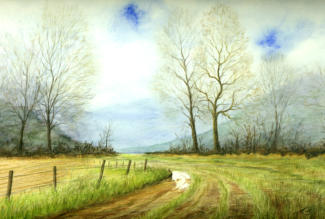
Peter drew the landscape containing winter trees, shown above, a few years ago. The basic tree trunks were lightly penciled in and the overall outline of the outer branches marked as a dotted line which established the shape.
When drawing tree branches he turns the paper upside down then sketches them in starting at the trunk and winding their way out, getting thinner as they go. The dotted line on the outer limits merges to become the fuzz of tiny twigs.
Drawing tree shapes
The trees here in the UK come in all shapes and sizes. A few different species are illustrated in the following sketch. If you intend to do a lot of landscapes in coloured pencil it might be worth investing in a tree identification book to ensure you get the shapes correct. However, if your trees are in the distance you do not have to be too worried about the exact variety of tree you include, but it does help to be aware of the different shapes.
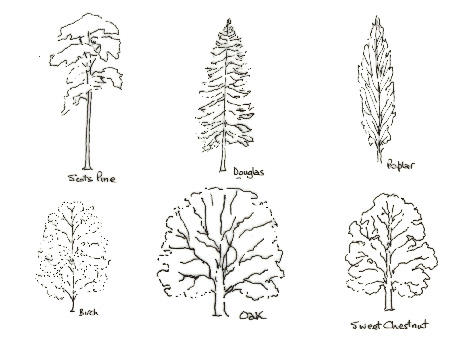
Upright forms like Pines, Firs and Poplars tend to have recognisable shapes.
More rounded tree forms like Birch, have a very light open structure and a light leaf cover. You can see a lot of sky through these trees.
The Oak tends to have a more solid appearance with a strong wide trunk and dense leaf cover.
Trees like the Sycamore and Sweet Chestnut have a similar round form to the Oak but a more open appearance with many 'sky holes'.
The pattern of the branches of each kind are shown in the above diagram. This helps to direct the foliage shape when you want to know how to draw trees in leaf. The foliage will often form blocks of leaves which will show light on the tops and shadows underneath each section. This will help give form to your summer trees.
The 'Skeleton' of a tree

Did you know that the amount of timber per cubic foot in a tree is the same amount all the way out to the outer limbs?
The tree carries the wood as solid material in the lower trunk and as each branch leaves the main stem, the tree trunk loses the same amount of timber as the branch takes away. To accommodate this loss the main limb narrows.
I must admit that I have yet to see a branch that gets wider and heavier as it extends out from the tree. The trees in the wood behind my house all seem to obey the 'rule', so until someone proves it to the contrary, I will go with it.
This was the first 'rule' I was taught when learning how to draw trees, so I always ensure that the branches get narrower as they move further away from the trunk.
I find the way the branches grow fascinating - from the wriggling branches of an old Oak to the straight limbs of a Poplar. Study those on the trees photographed here.
OF course, the branches are more visible in winter, when the trees have no leaf cover, but note that eve in high summer timber is still noticeable.
One of the joys in looking at woodland with a view to drawing it, is looking for contrasts of light and dark. Checking whether you can see the sky through the leafs and branches is also worthwhile. Sometimes the light direction will leave you with a silhouette or highlighted leaves will stand out against dark, shadowed backgrounds.
When considering how to draw trees always try to work from a reference. it doesn't have to be sharply focused as seeing the leaves as dark or light areas will help you more than seeing every leaf as a separate entity.
Draw what you see, not what you know is there.
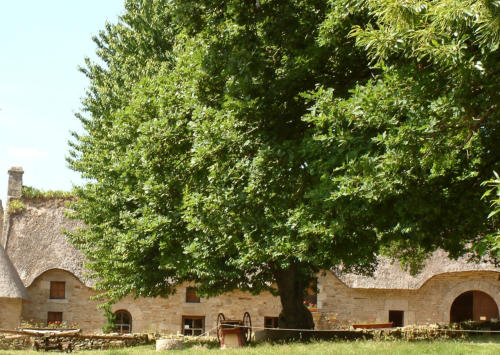 Huge Oak tree - not a branch in sight!
Huge Oak tree - not a branch in sight!
The colours of trees
Tree trunks in general have grey or greenish grey bark. Brown is found among conifers and exotic trees in the UK. Study tree trunks when you next go for a walk. Notice how the surface texture varies along with the colour, They can be ribbed, scaly or smooth. The amount of natural moss and algae growth will differ depending on the prevailing wind direction and this will help determine the overall colour.
Woodland will have a mixture of young trees and low bushes as well as mature trees so keep an eye on how how they differ in colour and texture. The seasons will also affect the colouration.

Different trees have different coloured foliage and even then it will vary between Spring and Autumn. Even in a single season it will rarely be possible to use just one coloured pencil for each tree or bush. The back of some leaves will be a different hue to the the front. Some will be bleached by the sunlight while others are in shadow and look much darker.
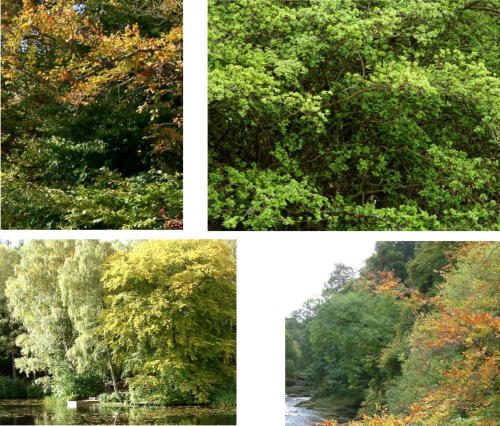
In the photographs below, check how the trees in the foreground are highlighted against those behind. The images on the right are close ups of the left hand photo, showing how the tops of the foliage in the sunlight differ from those that are in shade.
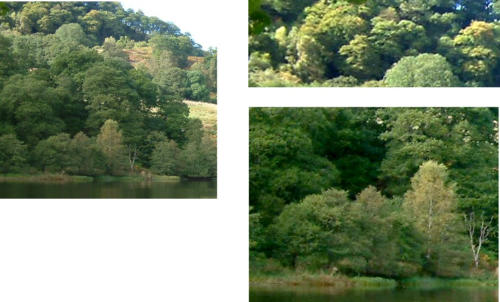
- Home
- Landscape drawing
- How to draw trees
Would you like our occasional newsletter?
Source: https://www.pencil-topics.co.uk/how-to-draw-trees.html
0 Response to "colored pencil drawing of trees"
Post a Comment